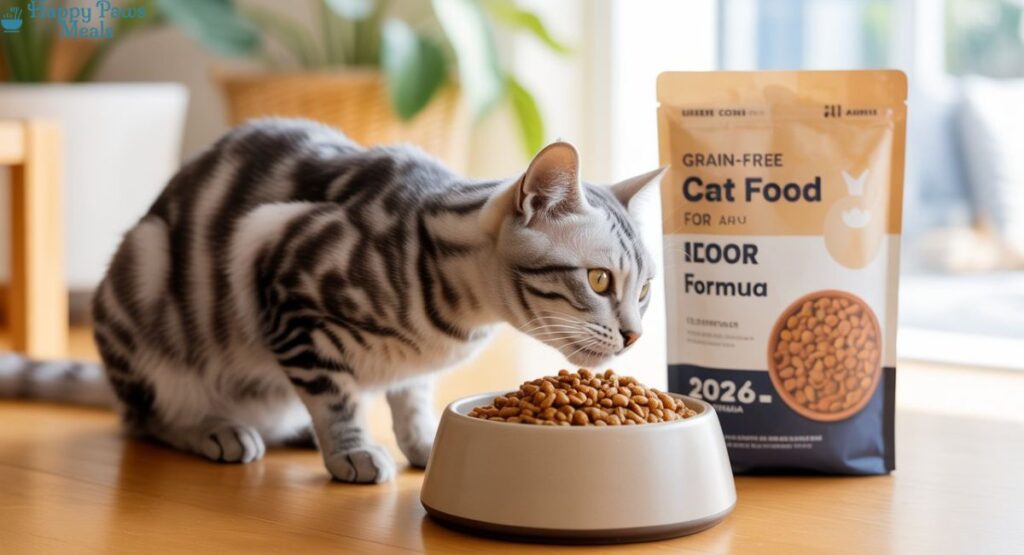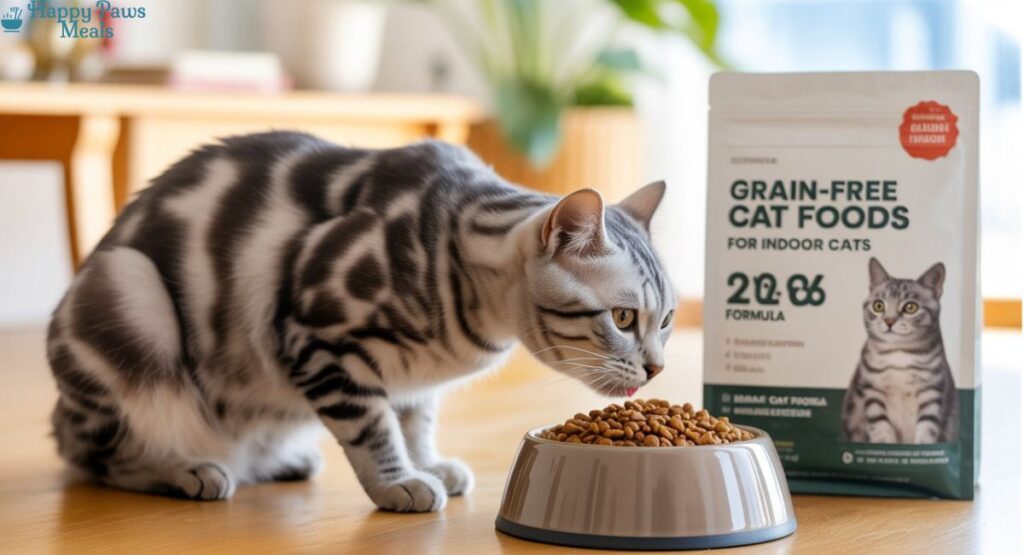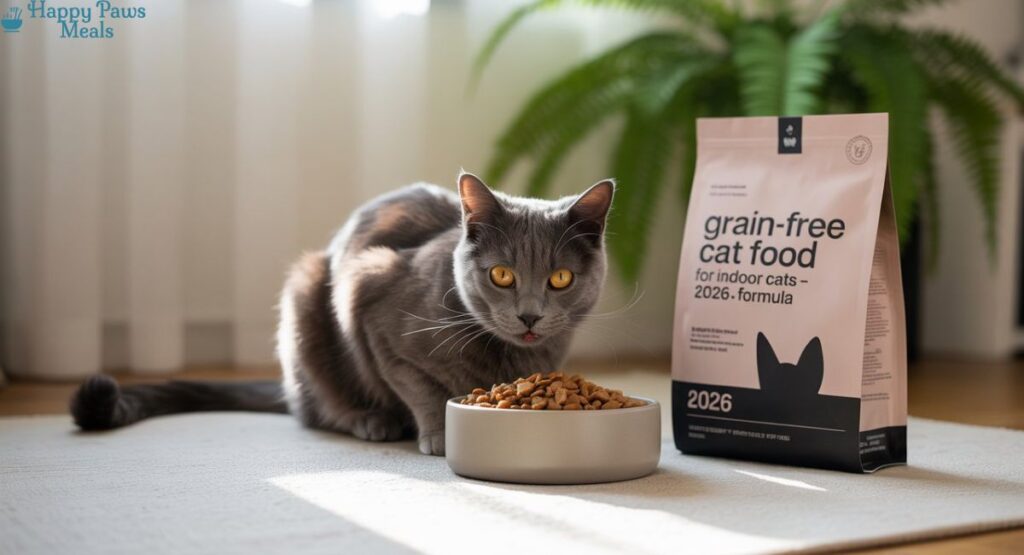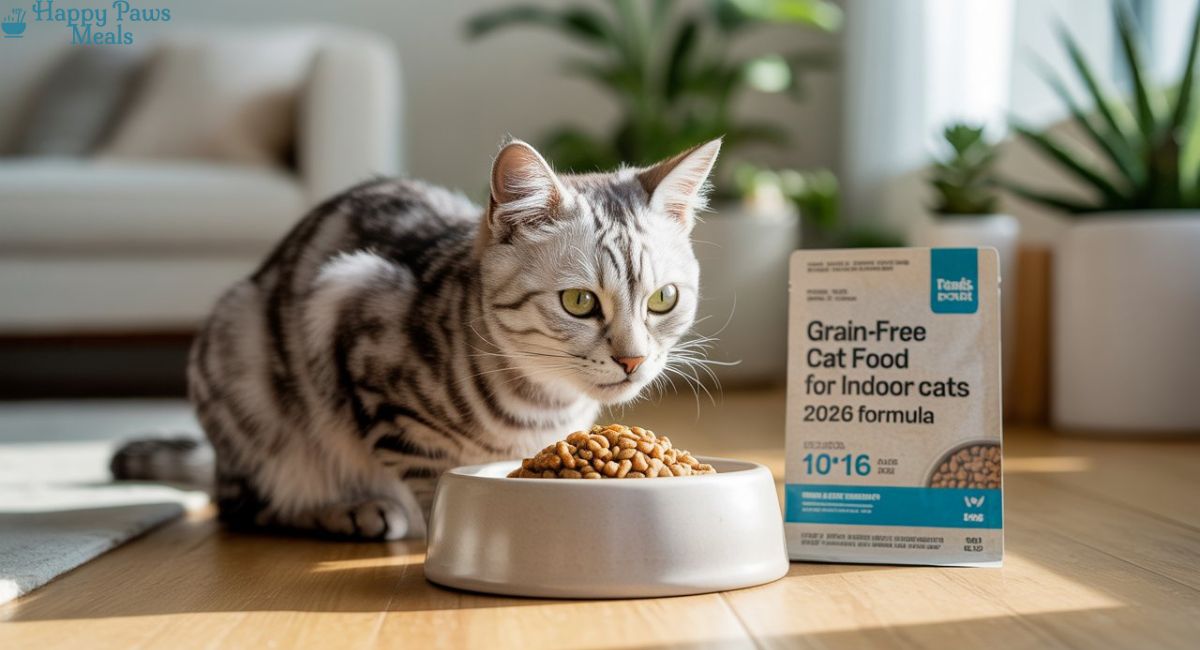Introduction
Indoor cats have different dietary needs compared to outdoor cats. Since they are less active, they require fewer calories but still need high-quality nutrition to stay healthy. In 2026, many cat owners are shifting toward grain-free cat food to support digestion, reduce allergies, and mimic a more natural feline diet. But with so many options on the market, how do you choose the best grain-free cat food for indoor cats in 2026?
This guide breaks it all down: from nutritional benefits and brand comparisons to FAQs and expert feeding tips. Choosing the right grain-free cat food for indoor cats helps prevent weight gain and keeps your pet active.
Want to figure out the exact portion size for your feline? Check out the Top Online Cat Food Calculators to make feeding your indoor cat easier and healthier.
Why Choose Grain-Free Cat Food for Indoor Cats?
Many vets recommend grain-free cat food for indoor cats because it supports better digestion and overall health.
- Easier Digestion – Cats are obligate carnivores, and many struggle to digest grains like corn, wheat, or soy.
- Allergy Reduction – Grain-free diets may help cats prone to food allergies or sensitivities.
- Weight Management – Indoor cats often gain weight easily. Grain-free formulas are typically higher in protein and lower in carbs.
- Shinier Coat & Skin Health – The extra protein and omega fatty acids improve skin and coat quality.
- Closer to a Natural Diet – Mimics what cats would eat in the wild: protein-rich and low in fillers.

Top 10 Best Grain-Free Cat Food for Indoor Cats in 2026
For a complete breakdown of nutritional requirements, you can check the AAFCO Cat Food Nutrient Standards Here are the best options reviewed and compared:
1. Blue Buffalo Wilderness Indoor Chicken Recipe
- Highlights: High protein, grain-free, made with real chicken.
- Best For: Indoor cats needing lean muscle support.
- Pros: Natural ingredients, includes LifeSource Bits with antioxidants.
- Cons: Slightly more expensive than regular dry cat food.
2. Wellness CORE Indoor Grain-Free Formula
- Highlights: Balanced formula with turkey, chicken, and natural fiber.
- Best For: Cats prone to hairballs.
- Pros: Great for digestion and coat health.
- Cons: Not all cats love the taste.
3. Orijen Cat & Kitten Grain-Free Dry Food
- Highlights: Biologically appropriate, with free-run chicken, turkey, and wild-caught fish.
- Best For: Cats that thrive on high-protein diets.
- Pros: Premium ingredients, nutrient-dense.
- Cons: Very high price point.
4. Taste of the Wild Rocky Mountain Grain-Free Cat Food
- Highlights: Roasted venison and salmon blend.
- Best For: Cats with sensitive stomachs.
- Pros: Novel proteins reduce allergy risk.
- Cons: Some formulas can be hard to find in stores.
5. Merrick Purrfect Bistro Grain-Free Indoor Recipe
- Highlights: Deboned chicken with probiotics.
- Best For: Cats needing digestive health support.
- Pros: Affordable premium option.
- Cons: Packaging sometimes inconsistent.

6. Instinct Original Grain-Free Cat Food
- Highlights: 70% animal ingredients, 30% veggies and fruits.
- Best For: Pet parents who want raw-inspired nutrition.
- Pros: Available in both kibble and wet food.
- Cons: Higher fat content may not suit all cats.
7. Nutro Grain-Free Indoor Cat Food
- Highlights: Farm-raised chicken, non-GMO ingredients.
- Best For: Cat owners who prefer clean-label food.
- Pros: No artificial preservatives or colors.
- Cons: Limited flavor choices.
8. ACANA Indoor Entrée Grain-Free Cat Food
- Highlights: Duck, chicken, and turkey mix.
- Best For: Indoor cats needing lean proteins.
- Pros: High-quality sourcing, nutrient-packed.
- Cons: Pricier than mid-range options.
9. Solid Gold Indigo Moon Grain-Free Cat Food
- Highlights: High-protein chicken recipe with probiotics.
- Best For: Active indoor cats.
- Pros: Boosts energy and digestion.
- Cons: Some cats take time to adjust.
10. Farmina N&D Grain-Free Chicken & Pomegranate
- Highlights: Italian-made, with fresh chicken and superfoods.
- Best For: Cats needing immune support.
- Pros: Premium superfood blend.
- Cons: Expensive and less available.
Nutritional Benefits of Grain-Free Cat Food
If your feline struggles with hairballs or sensitive stomach, grain-free cat food for indoor cats can make a big difference. Consistency matters! Learn more about setting the right schedule in our guide on Feeding Hours for Cats.

- Higher Protein: Supports muscle and energy levels.
- Better Digestion: No fillers or hard-to-digest grains.
- Weight Control: Lower carb content helps manage indoor cat weight.
- Skin & Coat Health: Omega-3 and omega-6 fatty acids improve coat shine.
- Stronger Immunity: Antioxidants and minerals support long-term health.
Is Grain-Free Cat Food Safe for Indoor Cats?
Yes, when chosen carefully. Grain-free diets are safe for most cats, but they must still meet AAFCO nutrient standards. Some grain-free diets may be higher in fat, so portion control is important.
👉 According to AAFCO’s Cat Food Nutrient Guidelines, a balanced diet should always meet feline protein, fat, and vitamin requirements. Pet owners love that grain-free cat food for indoor cats often contains higher protein, which matches a cat’s natural diet.
Feeding Tips for Indoor Cats on Grain-Free Diets
The market for grain-free cat food for indoor cats in 2026 is full of healthy options tailored to different needs. Many pet owners choose grain-free cat diets because they support healthier digestion and energy in indoor cats.
- Portion Control – Avoid overfeeding; indoor cats burn fewer calories.
- Mix Wet and Dry Food – Keeps hydration levels balanced.
- Regular Vet Checkups – Ensure your cat is maintaining healthy weight.
- Slow Transitions – Switch foods gradually over 7–10 days.
- Interactive Feeding – Use puzzle feeders to prevent boredom eating.
FAQs About Grain-Free Cat Food for Indoor Cats
Q1: Is grain-free cat food better for indoor cats?
Yes, it can support digestion, reduce allergies, and help with weight management. The best dry food for indoor cats often includes high-quality proteins and fewer fillers.
Q2: Can kittens eat grain-free cat food?
Yes, but choose formulas designed for kittens to ensure proper nutrient balance.
Q3: Does grain-free mean carb-free?
No, many still contain carbs from peas, potatoes, or lentils.
Q4: How do I know if my cat needs grain-free food?
Signs include frequent vomiting, diarrhea, skin irritation, or food allergies.
Q5: What’s the best grain-free wet cat food?
Brands like Instinct and Wellness offer great grain-free wet options. Indoor cats have unique needs, so a balanced indoor cat nutrition plan is important for long-term health.
Final Thoughts
Choosing the best grain-free cat food for indoor cats in 2026 doesn’t need to be overwhelming. Stick to trusted brands, check AAFCO nutritional adequacy, and consider your cat’s specific needs. Grain-free diets can help support digestion, coat health, and weight management — all crucial for a happy, healthy indoor cat. Choosing the right Grain-Free Cat Food for Indoor Cats ensures your pet gets balanced nutrition without unnecessary fillers.
By making the right choice, you’ll give your feline friend the nutrition they need to thrive in 2026 and beyond.

I’m Awais Manzoor, the writer behind HappyPawsMeals. With years of interest in pet care and nutrition, I research and review cat and dog food to provide reliable, easy-to-understand advice for pet parents.

